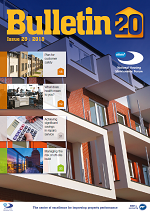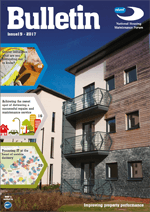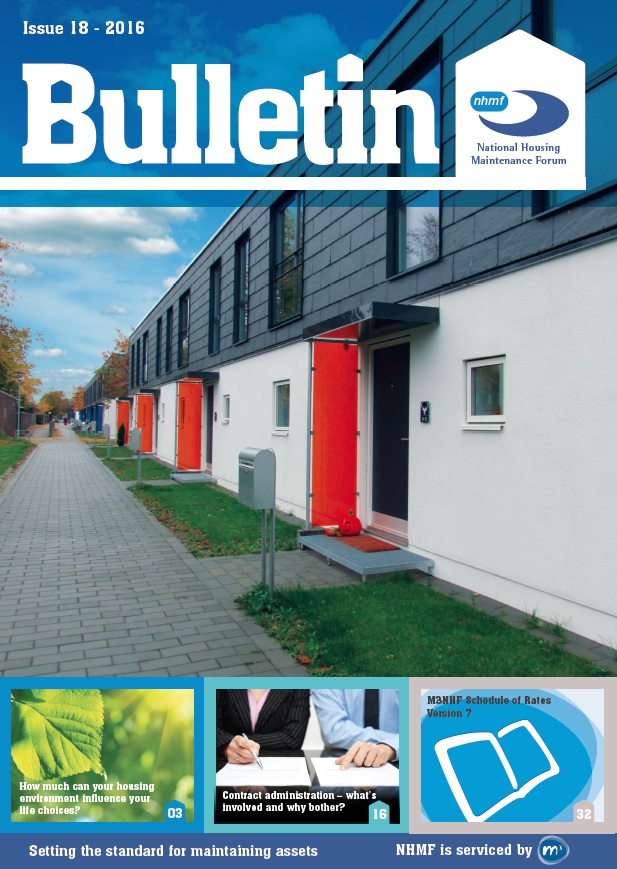NHMF best practice
These two new best practice sections will help social landlords to maintain quality homes in an increasingly challenging economic environment. The Compliance Section has a set of topical guides summarising social landlords’ responsibilities for meeting essential statutory health and safety requirements and explain how to do this economically and efficiently. The Fuel Saving Section explains how to include a fuel saving strategy as a key aspect of an organisation’s business plan. The Guide then sets out how to develop a practical improvement strategy as an integral part of the asset management programme and how to successfully deliver the improvements and manage the risks. There are also best practice training courses which relate to this guide.
Introduction: Drivers for fuel-saving home improvements
Reducing the fuel used in the housing stock should be an integral and essential part of every social landlord’s business plan. This guide focuses on fuel-saving home improvements rather than energy efficiency because these will reduce residents’ fuel bills and ensure homes continue to be affordable. While energy efficiency is the focus of legislation and policy, it does not, on its own, guarantee the reduced fuel bills necessary for social housing.
This guide explains why the business plan should include a fuel-saving strategy and how to make the business case to get the Governing Body, such as the Board, and senior management approval for a fuel-saving strategy and targets. It is important to get agreement to the business case first because, without it, there is no mandate for developing the detailed strategy to reduce residents’ fuel bills. Such an approach is driven by the organisation’s own objectives and business needs rather than chasing money from ever-changing and uncertain external funding schemes.
All social landlords will need to review and "stress test" their business plans in the light of the Government’s announcements on welfare reform and energy-efficiency policies in the 2015 Summer Budget and the Comprehensive Spending Review in November 2015. Those announcements, it is estimated, will reduce housing organisations’ rental income by £3.9bn over the next 10 years and would limit the amount residents receive in housing benefits -- see Chapter 3 for more detail. When carrying out their review, it is essential that landlords consider their strategy to reduce fuel use, either to revise the existing one or to agree one for the first time.
There will be very limited public funding for social landlords to carry out fuel saving improvements. Existing schemes, such as the Energy Company Obligation (ECO) will soon be exhausted because most energy companies have largely met their 2017 targets. Furthermore, social landlords are not eligible for the main fuel poverty schemes such as the Home Heating Cost Reduction Obligation (HHCRO/ Affordable Warmth) element of ECO or the new Warm Homes scheme in Northern Ireland. There is currently some funding for social landlords in Scotland and they have a mandatory standard to meet by 2020. Similarly in Wales funding for social landlords is linked to meeting the Welsh Housing Quality Standard. In both countries, that funding includes ECO and so future funding will depend on how quickly the ECO fund is exhausted -- see Chapter 1 for more detail.
Fuel poverty
All UK Governments have fuel poverty strategies and will be monitoring progress against different fuel poverty targets, particularly the LIHC indicator (low income high cost) that has superseded the 10% rule in England (see the discussion of fuel poverty below). The Fuel Poverty Strategy published by DECC in March 2015 is accompanied by the Fuel Poverty Regulations, which set a minimum energy efficiency target of EPC Band C by 2030, with interim milestones. These apply to all housing stock.
In Scotland and Wales, social landlords have to meet minimum energy efficiency standards set by Housing Regulators.
However, it is important to explain to the Governing Body that these minimum energy efficiency standards are inadequate to protect residents from fuel poverty because they are economic rather than performance-based.
Falling fuel prices reduce the imperative to improve efficiency while rising prices quickly overtake low standards. The combination of reduced income for those on benefits with projected increases in fuel prices will require far more challenging energy efficiency standards than the minima specified by Governments’ current fuel poverty strategies and by housing regulators. See Chapter 2 for a more detailed analysis.
Social landlords should set their own agenda and determine their own objectives and priorities rather than confining their aspirations to statutory minimum standards. Having a long-term fuel saving strategy in their business plan is a necessary part of meeting their social purpose and demonstrating social responsibility. It will enable them to provide truly affordable homes that keep residents warm and healthy, as well as safeguarding income streams as a vital part of an overall active asset management strategy. It will also enable social landlords to play their part in reducing carbon dioxide emissions and meeting climate change targets.
Once the business plan includes a fuel saving strategy as an integral part of the asset management strategy, landlords are well set-up to bid for any funding that fits with their planned programme. This is in contrast to approaches where the asset management programme is changed to secure funding - see Chapter 4.
What are the drivers?
While the energy efficiency of social housing does not feature much in current policy and funding in England, there are strong regulatory, business and social drivers for landlords to reduce the amount of fuel used in their stock. Each organisation should assess how important each driver is when developing its business plan. The main drivers are set out below:
Asset value (NPV) is an important aspect of any landlord’s business plan because it is the basis on which loans are negotiated (i.e. for new development). A well-maintained, fuel-efficient stock will be attractive to residents because it compares well with fuel-efficient new homes. While the investment required to improve stock may not increase its NPV, it will ensure it continues to provide affordable homes for residents, safeguard income streams and demonstrate that social purpose is being achieved. However, before any investment is planned, the existing NPV should be assessed as part of wider portfolio management. Fuel saving improvements to homes should help to reduce turnover, repairs, arrears and voids and maintain a strong asset base.
Legislation
o Fuel Poverty – the Government’s Fuel Poverty Strategy for England Cutting the Cost of Keeping Warm, which is based on the Hills definition of fuel poverty, includes a minimum Energy Performance Certificate (EPC) band C target for all fuel poor homes by 2030 and this is included in the Fuel Poverty (England) Regulations 2014. There are no exceptions for social housing. The strategy also includes interim milestones of band E by 2020 and band D by 2025. The Welsh, Northern Irish and Scottish Governments use the old definition of fuel poverty; specific requirements set for social housing by Wales with its Housing Quality Standard define an energy performance of at least SAP 65 and Scotland sets minimum SAP scores of 60 – 69. It is likely that social landlords will be scrutinised by Government and by housing regulators on their progress to meeting statutory, although inadequate, fuel poverty targets.
o Statutory carbon dioxide emissions targets – The Climate Change Act established a target for the UK to reduce its emissions by at least 80% from 1990 levels by 2050. Government expects housing, particularly social housing, to play a key role. It is probable that emissions reduction expectations for social housing will increase as the deadlines for this target approaches.
Maintaining affordable homes – this involves assessing what total housing costs residents can afford, including rent, energy, other utilities and any service charges. Factors to consider include residents’ incomes and how they will be affected by welfare reforms. Current rent arrears show whether there is already an affordability problem. To ensure homes remain affordable, total housing costs should be within an affordability target. This will not be the same for all residents and should be assessed by landlords based on detailed knowledge of their stock and their residents. To assess worst case scenarios, some landlords now use benefits income as the basis for affordability.
Business risks
o Reduced rental income when residents are in fuel poverty, combined with welfare reform or increased void rates and longer void periods for energy inefficient stock
o Liabilities from poorly maintained properties, such as additional repairs to deal with condensation and mould. Complaints of condensation and mould can trigger environmental health enforcement action under HHSRS and serious detriment rulings by housing regulators, with all the associated reputational damage
o Climate change effects such as storms, floods or increased subsidence resulting in damage to assets. It can also affect residents through overheating, flooding or drought and could increase void rates
Business benefits, value for money and cost effectiveness can be demonstrated by quantifying what is being achieved with current expenditure and how much more could be achieved by a small additional investment to integrate fuel saving into the broader asset management strategy. Additional factors should also be assessed, such as:
o Future maintenance costs, such as remedying condensation and mould growth, will be reduced when homes are made more affordable to heat, as will void rates and periods.
o An integrated strategy that reduces both costs and resident disruption, when compared with a separate "retrofit" programme.
o However, to ensure that future repair and maintenance work does not negate these improvements, some landlords have developed "Green repairs", where training is provided for maintenance teams to ensure they are aware of the effects of leaving unsealed holes in the building fabric, etc.
Value for money and cost effectiveness can more easily be demonstrated, using the Social Housing Regulator’s Value for Money Standard, when fuel saving is integrated into the broader asset management strategy because this reduces both costs and resident disruption, when compared with a separate ‘retrofit’ programme.
o In comparison with other maintenance and improvement work fuel saving improvements directly benefit residents by reducing fuel bills, thus demonstrating social value for money. They also generate economic benefits for the community because typically they will: employ local labour, including SMEs; provide local employment and training; and increase local economic activity.
o The Health and wellbeing of residents should be an important consideration for a social business, reflected in social responsibility strategies. Government fuel poverty strategies make reference to the health benefits of warmer homes and the need to reduce excess winter deaths attributed to living in fuel poverty. Severe health risks can be assessed using HHSRS. Some funding from local authorities and local clinical commissioning groups is currently available to scale up pilot projects examining the evidence for improved health from energy efficiency improvements. However, there are also business benefits from healthier tenants, such as more reliable income and potentially lower turnover (there is some anecdotal evidence of residents moving because of poor indoor air quality, dampness or cold). Indoor air quality is an important health factor, so adequate ventilation, too often neglected in fuel saving improvements, should be an integral aspect of all energy efficiency and fuel saving projects. It will also reduce the risk of condensation and mould, and the associated repair costs.
o Climate change poses business risks both to assets through storm and flood damage or increased subsidence and to residents through harsh winters combined with summer overheating and flooding or drought. A fuel saving strategy provides an opportunity to assess climate change risks and how to reduce them by means of adaptation measures. Where residents are on water meters, typically in water-scarce areas, there can also be economic benefits of considering water reduction measures as part of adaptation work.
Barriers and challenges
Such drivers, when supported by quantified benefits, will be important for overcoming negative organisational perceptions, barriers and challenges to fuel-saving improvements. This will be essential for convincing the Governing Body and senior management and for getting the mandate to make improving fuel saving an integral aspect of the business plan. It should also lead to a change in the organisation’s culture.
For example, voids and maintenance contracts, or possibly "standing orders" should include the work to be done to implement fuel saving when routine repairs and maintenance work are carried out, such as installing flow restrictors when replacing taps or LED lighting when luminaires need to be replaced.
Decent Homes programme
It is important for organisations to appreciate the inadequacy of meeting only the minimum standards set by Government, particularly in relation to reducing fuel poverty. Experience with the Decent Homes programme
illustrates the costs and disruption involved for landlords and residents to achieve a standard that included minimal energy performance improvement compared with today’s standards, let alone tomorrow’s. To avoid repeated improvement programmes organisations need to set ambitious fuel saving targets even though this will be challenging financially. Fuel saving targets may vary between landlords because for some their stock will be more difficult and expensive to improve than for others, but any targets should be challenging but realistic (higher than the statutory minima) to achieve the twin goals of reducing fuel poverty and reducing carbon dioxide emissions.
This guide
The rest of this guide explains how to get agreement for an ambitious and challenging fuel saving strategy and then how to deliver it.
Next Chapter




